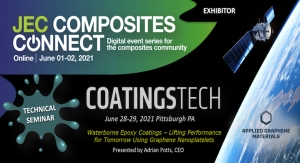Kerry Pianoforte, Editor05.09.17
The American Coatings Association (ACA) held its 2017 CoatingsTech Conference March 20-22 in Cleveland, Ohio. Held every two years, on alterative years with the American Coatings Show and Conference, the theme of this year’s CoatingsTech Conference was “Meeting the Sustainable Challenges of Today and Tomorrow.” According to the show’s organizers, the CoatingsTech Conference was a success with attendance reaching a record-breaking 310. The Conference featured insight from coatings manufacturing companies, suppliers, academia and government.
Prior to the conference, the ACA hosted a series of specially designed short courses and open forums addressing both the fundamentals and emerging developments in coatings technology. These included: “Coatings ‘101’: An Introduction,” “Paint Film Defects – Assessing Problems and Aligning Solutions,”“Weathering and Service Life: Challenges for Innovation,” “Smart & Multi-Functional Coatings,” “R&D Management – Giving Projects the Go: From Fostering Ideas to Finding Funding” and “Special Challenges in R&D.”
Keynote Address and Mattiello Lecture
The Coating Tech Conference commenced with a keynote address from David Bem, vice president of Science and Technology and chief technology officer at PPG. Bem discussed current and emerging markets and spoke about the impact of regulatory trends.
Dr. Jamil Baghdachi, delivered the conference’s Mattiello Lecture. Baghdachi, professor at Eastern Michigan University’s School of Engineers, gave a lecture titled, “Smart and Functional Polymers and Coatings.” Baghdachi’s lecture focused on breakthroughs in the development of smart and self-healing coatings. Applications for these types of coatings are numerous and include automotive and OEM coatings. Baghdachi also received the Joseph J. Mattiello Award for his lecture. This award is bestowed after a peer nomination process recognizing outstanding contributions to science, technology and/or engineering related to the coatings industry.
Following the keynote address and lecture, the conference’s technical conference began with a two-day, multi-track concurrent format covering seven topic areas:
˚ Advanced Analytics and Modeling Strategies
• Novel Materials
• Smart and Multifunctional Coatings
• Weathering and Service Life/Paint Defects
• Bio-based Solutions
• Industrial Coatings
• Product Stewardship
The inaugural CoatingsTech Best Paper Award was presented to Kurt Wood, principal scientist at Arkema, for his paper “Evaluation of the ASTM D7869-13 Test Method to Predict the Gloss and Color Retention of Premium Architectural Finishes.”
The Student Poster session was held at the end of the first. According to the ACA, “this poster competition offered a non-commercial arena for new ideas and techniques, and showcase for preliminary results related to chemistry, engineering, human relationship, or other discipline fundamental to paint, coatings, varnish, lacquer, or related protective and decorative coatings.”

Kyle Aidukas of California Polytechnic State University, was the first-place winner for his poster, “Graphene Oxide-Polyurethane Composites for Corrosion Inhibition.” Brittany Pellegrene of the University of Akron, won second place for her poster, “Visible Light Curable Alkyd Coatings.”
The 2017 CoatingsTech Conference ended with a full-day special session examining the coatings industry’s role in meeting regulatory and sustainability challenges that support end users. Keynote speaker, Mike Morris, a program supervisor for California’s South Coast Air Quality Management District’s (SCAQMD) Air Toxics Unit of Planning, Rule Development and Area Sources addressed the air district’s plans for Architectural Coatings Rule 1113; Architectural Coatings Fees Rule 314; Test Method 313; and the 2016 Air Quality Management Plan.
The session was comprised of ten additional speakers including leaders from regulatory agencies, coatings industry compliance experts and staff from ACA’s Government Affairs and Environmental Health and Safety divisions.



















